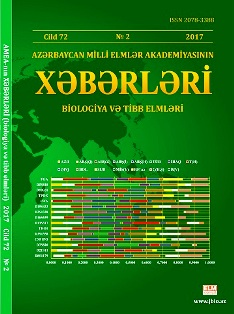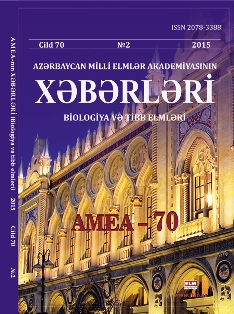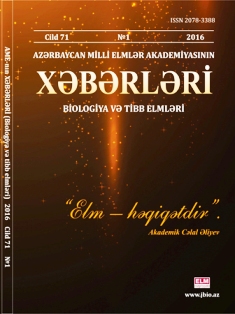
Rapid and simple detection of SARS-CoV-2 with point-of-care COVID-19 testing
Research article: Rapid and simple detection of SARS-CoV-2 with point-of-care COVID-19 testing
Authors: A. Eftekhari1,2*, A.N. Nasibova2,4, R.I. Khalilov2,3,4
1Pharmacology and Toxicology Department, Maragheh University of Medical Sciences, Maragheh, Iran 2Joint Ukraine-Azerbaijan International Research and Education Center of Nanobiotechnology and Functional Nanosystems, Drohobych, Ukraine & Azerbaijan
3Department of Biophysics and Biochemistry, Baku State University, 23 academician Z.Khalilov Str., Baku AZ1148, Azerbaijan
4Institute of Radiation Problems, Azerbaijan National Academy of Sciences, 9 B.Vahabzadeh Str., Baku AZ1143, Azerbaijan
*For correspondence: eftekharia@tbzmed.ac.ir
Received 21 September 2020; Received in revised form 16 November 2020; Accepted 16 November 2020
Abstract:
COVID-19 as a public health concern of the world has spread worldwide and a combination of vari- ous methods including tomography imaging, reverse transcription-polymerase chain reaction (RT- PCR), enzyme-linked immunosorbent assay (ELISA) and cell culturing were developed to detect and identify SARS-CoV-2. Due to the absence of specific antiviral agents or vaccines for COVID-19 treat- ment, early detection and identification are vital. An alternative, sensitive, fast point-of-care (POC) detection tool that can be routinely used by health care providers utilizing biological fluids as a spec- imen before starting an emergency process is desired. Efforts are underway to develop more effective diagnostic and surveillance technologies with loop-mediated isothermal amplification (LAMP) tests, antibody testing and microfluidic RT-PCR devices (Lab-on-a-chip). Point-of-care diagnostics are promising candidates in SARS-Cov-2 detection and encourage scientists to improve their technolo- gies beyond conception. The reverse transcription LAMP (RT-LAMP) method developed for SARS- CoV-2 could detect the virus even in saliva samples in less than an hour (Harapan et al., 2020). Lab- on-a-chip devices contain a small size chip, microchannel, microelectrodes and microheater. Cell ly- sis, DNA extraction and PCR amplification stages could be integrated on these microchips (Sharma et al., 2020). Because of the rapid detection, small volume of the specimen and integration with PCR in a portable tiny system, these devices are promising for SARS-CoV-2 detection (Huang et al., 2018). The validity and sensitivity of all the above-mentioned methods need to be improved for salivary specimen usage; in case of improvement, they might provide an opportunity for salivary detection of the virus without a waiting period and complex analytical infrastructure.
Keywords: COVID-19; RT-PCR; polymer chip; thermocycler; emergency situations; biosensors
References
Ahmad R., Mahmoudi, T., Ahn M.S., Hahn Y. B. (2018) Recent advances in nanowires-based field-effect transistors for biological sensor appli-cations. Biosensors and Bioelectronics, 100: 312-325.
Barone S., Chakhunashvili A., Comelli A. (2020) Building a statistical surveillance dash-board for COVID-19 infection worldwide. J. Quality Engineering, 32(4):754-763.
Berry A., Fillaux, J., Martin-Blondel, G., Bois-sier, J. et al. (2016) Evidence for a permanent presence of schistosomiasis in Corsica, France. Eurosurveillance, 21(1): 30100.
Cassaniti I., Novazzi F., Giardina F. et al. (2020) Performance of VivaDiag COVID‐19 IgM/IgG Rapid Test is inadequate for diagnosis of COVID‐19 in acute patients referring to emer-gency room department. Journal of Medical Vi-rology, 92(10): 1724.
Chan J.F.-W., Yuan S., Kok K.H. et al. (2020) A familial cluster of pneumonia associated with the 2019 novel coronavirus indicating person-to-per-son transmission: a study of a family cluster. The Lancet, 395(10223): 514-523.
Cho C.H., Lee, C.K., Nam M.H. et al. (2014) Evaluation of the AdvanSure™ real-time RT-PCR compared with culture and Seeplex RV15 for simultaneous detection of respiratory viruses. Diagnostic microbiology and infectious disease, 79(1): 14-18
Chu D.K., Pan Y., Cheng S.M. et al. (2020) Mo-lecular diagnosis of a novel coronavirus (2019-nCoV) causing an outbreak of pneu-monia. Clinical Chemistry, 66(4): 549-555.
Galvez L.C., Barbosa C.F.C., Koh R.B.L. et al. (2020) Loop-mediated isothermal amplification (LAMP) assays for the detection of abaca bunchy top virus and banana bunchy top virus in abaca. Crop Protection, 131: 105101.
Harapan H., Itoh N., Yufika A. et al. (2020) Coronavirus disease 2019 (COVID-19): A litera-ture review. Journal of Infection and Public Health, 13(5): 667-673
Hoffman T., Nissen K., Krambrich J. et al. (2020) Evaluation of a COVID-19 IgM and IgG rapid test; an efficient tool for assessment of past exposure to SARS-CoV-2. Infection Ecology & Epidemiology, 10(1): 1754538
Huang P., Wang, H., Cao Z. et al. (2018) A rapid and specific assay for the detection of MERS-CoV. Frontiers in Microbiology, 9: 1101
Kurbanoglu S., Erkmen C., Uslu B. (2020). Frontiers in electrochemical enzyme based bio-sensors for food and drug analysis. TrAC Trends in Analytical Chemistry, 124: 115809.
Labarrere C.A., Woods J.R., Hardin J.W. et al. (2011) Early prediction of cardiac allograft vas-culopathy and heart transplant failure. American Journal of Transplantation, 11(3): 528-535.
Liaw C.W.J., Lim A.S.E., Koh W.H.V. et al. (2012) Epidemiology of the four human corona-viruses 229E, HKU1, NL63 and OC43 detected over 30 months in the Singapore military. Interna-tional Journal of Infectious Diseases, 16: e135.
Mavrikou S., Moschopoulou G., Tsekouras V. et al. (2020). Development of a Portable, Ultra-Rapid and Ultra-Sensitive Cell-Based Biosensor for the Direct Detection of the SARS-CoV-2 S1 Spike Protein Antigen. Sensors, 20(11): 3121
Nagamine K., Hase T., Notomi T.J.M.C.P. (2002) Accelerated reaction by loop-mediated isothermal amplification using loop primers. Mo-lecular and Cellular Probes, 16(3): 223-229.
Nguyen T., Zoëga Andreasen, S., Wolff, A. et al. (2018). From lab on a chip to point of care de-vices: The role of open source microcontrollers. Micromachines, 9(8): 403.
Nguyen T., Duong Bang D., Wolff A.J.M. (2020) 2019 novel coronavirus disease (COVID-19): paving the road for rapid detection and point-of-care diagnostics. Micromachines, 11(3): 306.
Petryayeva E., Krull U.J. (2011) Localized sur-face plasmon resonance: Nanostructures, bioas-says and biosensing - A review. Analytica Chim-ica Acta, 706(1): 8-24.
Qiu G., Gai Z., Tao Y. et al. (2020) Dual-func-tional plasmonic photothermal biosensors for highly accurate severe acute respiratory syn-drome coronavirus 2 detection. ACS Nano, 14(5): 5268-5277.
Sharma A., Tiwari S., Deb M.K. et al. (2020) Se-vere Acute Respiratory Syndrome Coronavirus-2 (SARS-CoV-2): A global pandemic and treat-ments strategies. Int. Journal of Antimicrobial Agents, 56(2): 106054.
Sin M.L., Mach K.E., Wong P.K. et al. (2014) Advances and challenges in biosensor-based di-agnosis of infectious diseases. Expert Review of Molecular Diagnostics, 14(2): 225-244.
To K.K.W., Tsang O.T.‐Y., Leung W.‐S. et al. (2020) Temporal profiles of viral load in poste-rior oropharyngeal saliva samples and serum an-tibody responses during infection by SARS‐CoV‐2: an observational cohort study. Lancet In-fect. Dis., 20(5): 565-574.
Yang X., Yu Y., Xu J. et al. (2020) Clinical course and outcomes of critically ill patients with SARS-CoV-2 pneumonia in Wuhan, China: a single-centered, retrospective, observational study. The Lancet Respiratory Medicine, 8(5): 475-481.
Yuce M., Filiztekin E., Ozkaya K.G. (2020) COVID-19 diagnosis - A review of current meth-ods. Biosensors and Bioelectronics, 172(15): 112752.























